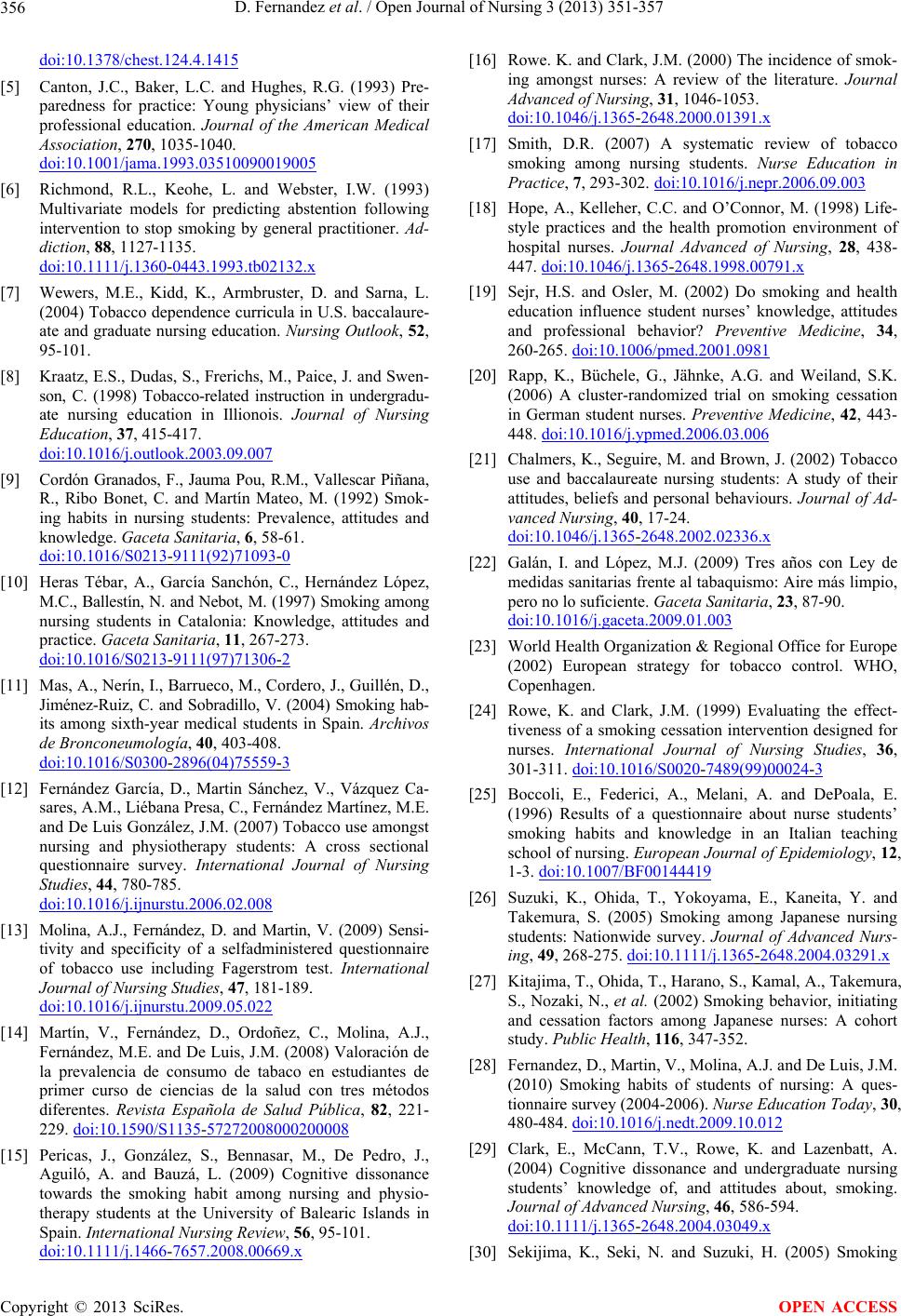
D. Fernandez et al. / Open Journal of Nursing 3 (2013) 351-357
356
doi:10.1378/chest.124.4.1415
[5] Canton, J.C., Baker, L.C. and Hughes, R.G. (1993) Pre-
paredness for practice: Young physicians’ view of their
professional education. Journal of the American Medical
Association, 270, 1035-1040.
doi:10.1001/jama.1993.03510090019005
[6] Richmond, R.L., Keohe, L. and Webster, I.W. (1993)
Multivariate models for predicting abstention following
intervention to stop smoking by general practitioner. Ad-
diction, 88, 1127-1135.
doi:10.1111/j.1360-0443.1993.tb02132.x
[7] Wewers, M.E., Kidd, K., Armbruster, D. and Sarna, L.
(2004) Tobacco dependence curricula in U.S. baccalaure-
ate and graduate nursing education. Nursing Outlook, 52,
95-101.
[8] Kraatz, E.S., Dudas, S., Frerichs, M., Paice, J. and Swen-
son, C. (1998) Tobacco-related instruction in undergradu-
ate nursing education in Illionois. Journal of Nursing
Education, 37, 415-417.
doi:10.1016/j.outlook.2003.09.007
[9] Cordón Granados, F., Jauma Pou, R.M., Vallescar Piñana,
R., Ribo Bonet, C. and Martín Mateo, M. (1992) Smok-
ing habits in nursing students: Prevalence, attitudes and
knowledge. Gaceta Sanitaria, 6, 58-61.
doi:10.1016/S0213-9111(92)71093-0
[10] Heras Tébar, A., García Sanchón, C., Hernández López,
M.C., Ballestín, N. and Nebot, M. (1997) Smoking among
nursing students in Catalonia: Knowledge, attitudes and
practice. Gacet a Sanitaria, 11, 267-273.
doi:10.1016/S0213-9111(97)71306-2
[11] Mas, A., Nerín, I., Barrueco, M., Cordero, J., Guillén, D.,
Jiménez-Ruiz, C. and Sobradillo, V. (2004) Smoking hab-
its among sixth-year medical students in Spain. Archivos
de Bronconeumología, 40, 403-408.
doi:10.1016/S0300-2896(04)75559-3
[12] Fernández García, D., Martin Sánchez, V., Vázquez Ca-
sares, A.M., Liébana Presa, C., Fernández Martínez, M.E.
and De Luis González, J.M. (2007) Tobacco use amongst
nursing and physiotherapy students: A cross sectional
questionnaire survey. International Journal of Nursing
Studies, 44, 780-785.
doi:10.1016/j.ijnurstu.2006.02.008
[13] Molina, A.J., Fernández, D. and Martin, V. (2009) Sensi-
tivity and specificity of a selfadministered questionnaire
of tobacco use including Fagerstrom test. International
Journal of Nursing Studies, 47, 181-189.
doi:10.1016/j.ijnurstu.2009.05.022
[14] Martín, V., Fernández, D., Ordoñez, C., Molina, A.J.,
Fernández, M.E. and De Luis, J.M. (2008) Valoración de
la prevalencia de consumo de tabaco en estudiantes de
primer curso de ciencias de la salud con tres métodos
diferentes. Revista Española de Salud Pública, 82, 221-
229. doi:10.1590/S1135-57272008000200008
[15] Pericas, J., González, S., Bennasar, M., De Pedro, J.,
Aguiló, A. and Bauzá, L. (2009) Cognitive dissonance
towards the smoking habit among nursing and physio-
therapy students at the University of Balearic Islands in
Spain. International Nursing Review, 56, 95-101.
doi:10.1111/j.1466-7657.2008.00669.x
[16] Rowe. K. and Clark, J.M. (2000) The incidence of smok-
ing amongst nurses: A review of the literature. Journal
Advanced of Nursing, 31, 1046-1053.
doi:10.1046/j.1365-2648.2000.01391.x
[17] Smith, D.R. (2007) A systematic review of tobacco
smoking among nursing students. Nurse Education in
Practice, 7, 293-302. doi:10.1016/j.nepr.2006.09.003
[18] Hope, A., Kelleher, C.C. and O’Connor, M. (1998) Life-
style practices and the health promotion environment of
hospital nurses. Journal Advanced of Nursing, 28, 438-
447. doi:10.1046/j.1365-2648.1998.00791.x
[19] Sejr, H.S. and Osler, M. (2002) Do smoking and health
education influence student nurses’ knowledge, attitudes
and professional behavior? Preventive Medicine, 34,
260-265. doi:10.1006/pmed.2001.0981
[20] Rapp, K., Büchele, G., Jähnke, A.G. and Weiland, S.K.
(2006) A cluster-randomized trial on smoking cessation
in German student nurses. Preventive Medicine, 42, 443-
448. doi:10.1016/j.ypmed.2006.03.006
[21] Chalmers, K., Seguire, M. and Brown, J. (2002) Tobacco
use and baccalaureate nursing students: A study of their
attitudes, beliefs and personal behaviours. Journal of Ad-
vanced Nursing, 40, 17-24.
doi:10.1046/j.1365-2648.2002.02336.x
[22] Galán, I. and López, M.J. (2009) Tres años con Ley de
medidas sanitarias frente al tabaquismo: Aire más limpio,
pero no lo suficiente. Gaceta Sanitaria, 23, 87-90.
doi:10.1016/j.gaceta.2009.01.003
[23] World Health Organization & Regional Office for Europe
(2002) European strategy for tobacco control. WHO,
Copenhagen.
[24] Rowe, K. and Clark, J.M. (1999) Evaluating the effect-
tiveness of a smoking cessation intervention designed for
nurses. International Journal of Nursing Studies, 36,
301-311. doi:10.1016/S0020-7489(99)00024-3
[25] Boccoli, E., Federici, A., Melani, A. and DePoala, E.
(1996) Results of a questionnaire about nurse students’
smoking habits and knowledge in an Italian teaching
school of nursing. European Journal of Epidemiology, 12,
1-3. doi:10.1007/BF00144419
[26] Suzuki, K., Ohida, T., Yokoyama, E., Kaneita, Y. and
Takemura, S. (2005) Smoking among Japanese nursing
students: Nationwide survey. Journal of Advanced Nurs-
ing, 49, 268-275. doi:10.1111/j.1365-2648.2004.03291.x
[27] Kitajima, T., Ohida, T., Harano, S., Kamal, A., Takemura,
S., Nozaki, N., et al. (2002) Smoking behavior, initiating
and cessation factors among Japanese nurses: A cohort
study. Public Health, 116, 347-352.
[28] Fernandez, D., Martin, V., Molina, A.J. and De Luis, J.M.
(2010) Smoking habits of students of nursing: A ques-
tionnaire survey (2004-2006). Nurse Education Today, 30,
480-484. doi:10.1016/j.nedt.2009.10.012
[29] Clark, E., McCann, T.V., Rowe, K. and Lazenbatt, A.
(2004) Cognitive dissonance and undergraduate nursing
students’ knowledge of, and attitudes about, smoking.
Journal of Advanced Nursing, 46, 586-594.
doi:10.1111/j.1365-2648.2004.03049.x
[30] Sekijima, K., Seki, N. and Suzuki, H. (2005) Smoking
Copyright © 2013 SciRes. OPEN ACCESS